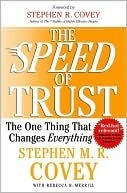More on this book
Community
Kindle Notes & Highlights
In establishing a new relationship where you want to build trust fast, follow this process: Find a value-added reason to make a commitment and keep it . . . and do it again . . . and again . . . and again. As you implement this “Make-Keep-Repeat” cycle, notice how quickly the Trust Account grows.
• The next time you make a commitment to someone at work, be sure the commitment is realistic. Even if you have to disappoint someone, it’s far better to do it up front than to overpromise and under deliver. Make sure you follow through with what you’ve committed to do. If you have to miss a deadline, attempt to renegotiate expectations as early as possible; don’t just ignore it and be late.
SUMMARY: BEHAVIOR #12—KEEP COMMITMENTS Say what you’re going to do, then do what you say you’re going to do. Make commitments—both explicit and implicit—very carefully, and keep them at almost all costs. Communicate when you can’t. Make keeping commitments the symbol of your honor. Don’t break confidences. Don’t attempt to “spin” your way out of a commitment you’ve broken.
The counterfeit of Extend Trust takes one of two forms. The first is extending “false trust.” It’s giving people the responsibility, but not the authority or resources, to get a task done. The second is extending “fake trust”—acting like you trust someone when you really don’t. In other words, you entrust someone with a job, but at the end of the day, you “snoopervise,” hover over or “big brother” the person, or perhaps even do his job for him.
SUMMARY: BEHAVIOR #13—EXTEND TRUST Demonstrate a propensity to trust. Extend trust abundantly to those who have earned your trust. Extend trust conditionally to those who are earning your trust. Learn how to appropriately extend trust to others based on the situation, risk, and credibility (character and competence) of the people involved. But start with a propensity to trust. Don’t withhold trust because there is risk involved.
With regard to trust, additional Gallup research shows that 96 percent of engaged employees—but only 46 percent of actively disengaged employees—trust management.
execution is appropriately a huge focus in organizations today, and execution is significantly enhanced by trust.
Whether you lose the trust of others through a conscious act of betrayal, poor judgment, an honest mistake, a failure of competence, or a simple misunderstanding, the path to restoration is the same—to increase your personal credibility and behave in ways that inspire trust.


